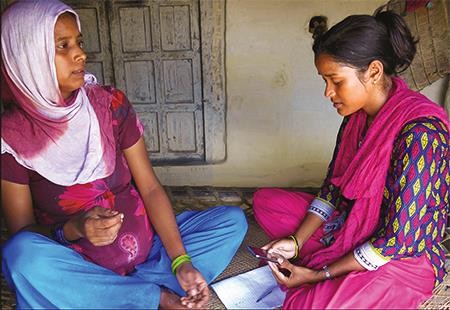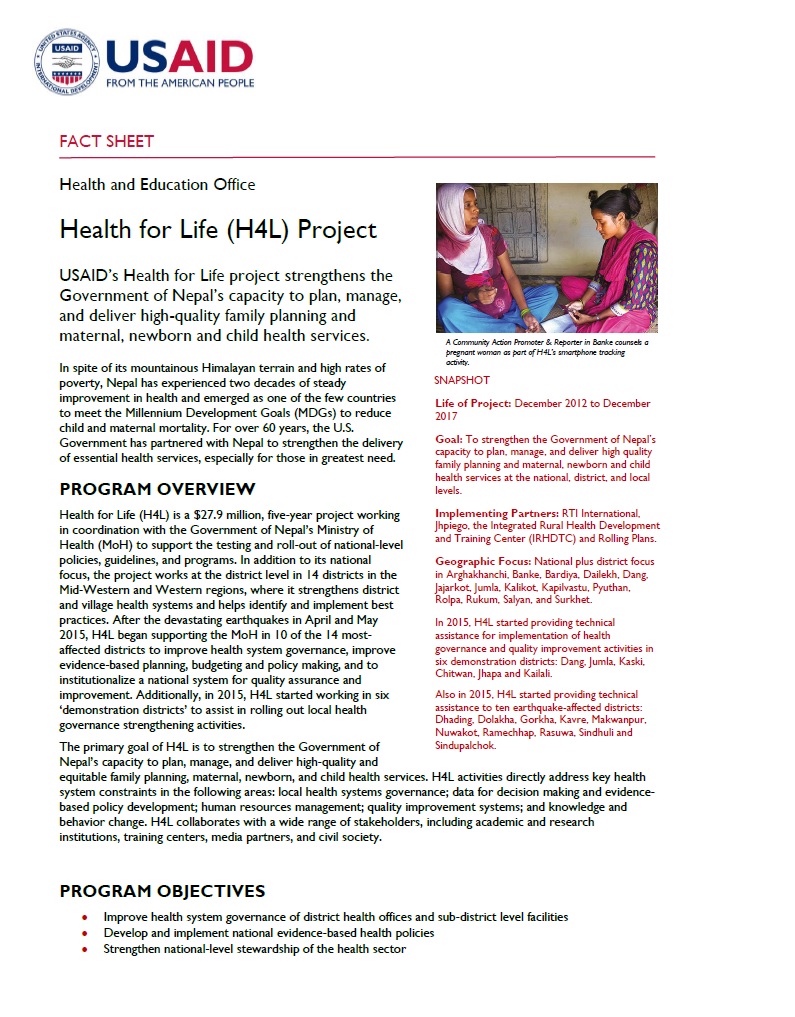
Health for Life (H4L) Project
USAID’s Health for Life project strengthens the Government of Nepal’s capacity to plan, manage, and deliver high-quality family planning and maternal, newborn and child health services.
PROGRAM OVERVIEW
In spite of its mountainous Himalayan terrain and high rates of poverty, Nepal has experienced two decades of steady improvement in health and emerged as one of the few countries to meet the Millennium Development Goals (MDGs) to reduce child and maternal mortality. For over 60 years, the U.S. Government has partnered with Nepal to strengthen the delivery of essential health services, especially for those in greatest need.
Health for Life (H4L) is a $27.9 million, five-year project working in coordination with the Government of Nepal’s Ministry of Health (MoH) to support the testing and roll-out of national-level policies, guidelines, and programs. In addition to its national focus, the project works at the district level in 14 districts in the Mid-Western and Western regions, where it strengthens district and village health systems and helps identify and implement best practices. After the devastating earthquakes in April and May 2015, H4L began supporting the MoH in 10 of the 14 most-affected districts to improve health system governance, improve evidence-based planning, budgeting and policy making, and to institutionalize a national system for quality assurance and improvement. Additionally, in 2015, H4L started working in six ‘demonstration districts’ to assist in rolling out local health governance strengthening activities.
Health for Life (H4L) project ![]() (pdf - 204k)
(pdf - 204k)
The primary goal of H4L is to strengthen the Government of Nepal’s capacity to plan, manage, and deliver high-quality and equitable family planning, maternal, newborn, and child health services. H4L activities directly address key health system constraints in the following areas: local health systems governance; data for decision making and evidence-based policy development; human resources management; quality improvement systems; and knowledge and behavior change. H4L collaborates with a wide range of stakeholders, including academic and research institutions, training centers, media partners, and civil society.
PROGRAM OBJECTIVES
- Improve health system governance of district health offices and sub-district level facilities
- Develop and implement national evidence-based health policies
- Strengthen national-level stewardship of the health sector
- Institutionalize a nationwide system for health care quality improvement
- Improve the capacity of district and local level health workers and community volunteers to deliver high-quality family planning and maternal and child health and nutrition services
- Improve the knowledge, behavior and use of health services among target populations
- Strengthen the capacity of USAID’s contractor, LifeLine Nepal, to improve Nepal’s health logistics system'
PROGRAM ACTIVITIES
- Strengthen Health Facility Operations and Management Committees (HFOMCs)
- Train local officials to better manage health care services for all, especially for marginalized and disadvantaged persons, and to incorporate community and client feedback from HFOMCs, social audits and public hearings
- Establish and strengthen mechanisms for timely, evidence-based decision making to respond effectively to local health needs
- Test and scale up a health service quality improvement system suitable for Nepal
- Improve quality pre-service training for Auxiliary Nurse Midwives and clinical skills of lower-level health workers
- Address equitable access to health services by improving health seeking behaviors, especially to historically underserved groups
- Coordinate recovery and reconstruction activities in earthquake-affected districts
KEY RESULTS
H4L will support the Government of Nepal (GoN) to achieve the following results:
- The GoN decentralizes planning and budgeting and localizes health governance to meet the needs of communities according to a collaborative framework and implementation guidelines
- Implementation of the Collaborative Frameword in six demonstration districts laying a foundation for nation-wide scale-up
- HFOMCs effectively manage facilities, helping improve access to and use of health services and improved quality of care
- District and regional MoH review meetings effectively use data to identify and monitor actions to improve performance
- The National Health Research Council leads a collaborative process with academics, practitioners and donors to prioritize studies for a national research agenda
- Facility-based quality improvement system is institutionalized nationwide
- Gender-based violence and early marriage are reduced
- Pre-service training and teaching methods for Auxiliary Nurse Midwives strengthened
- Use of maternal, newborn, child health and family planning services is increased among adolescents, and marginalized and disadvantaged groups








Comment
Make a general inquiry or suggest an improvement.